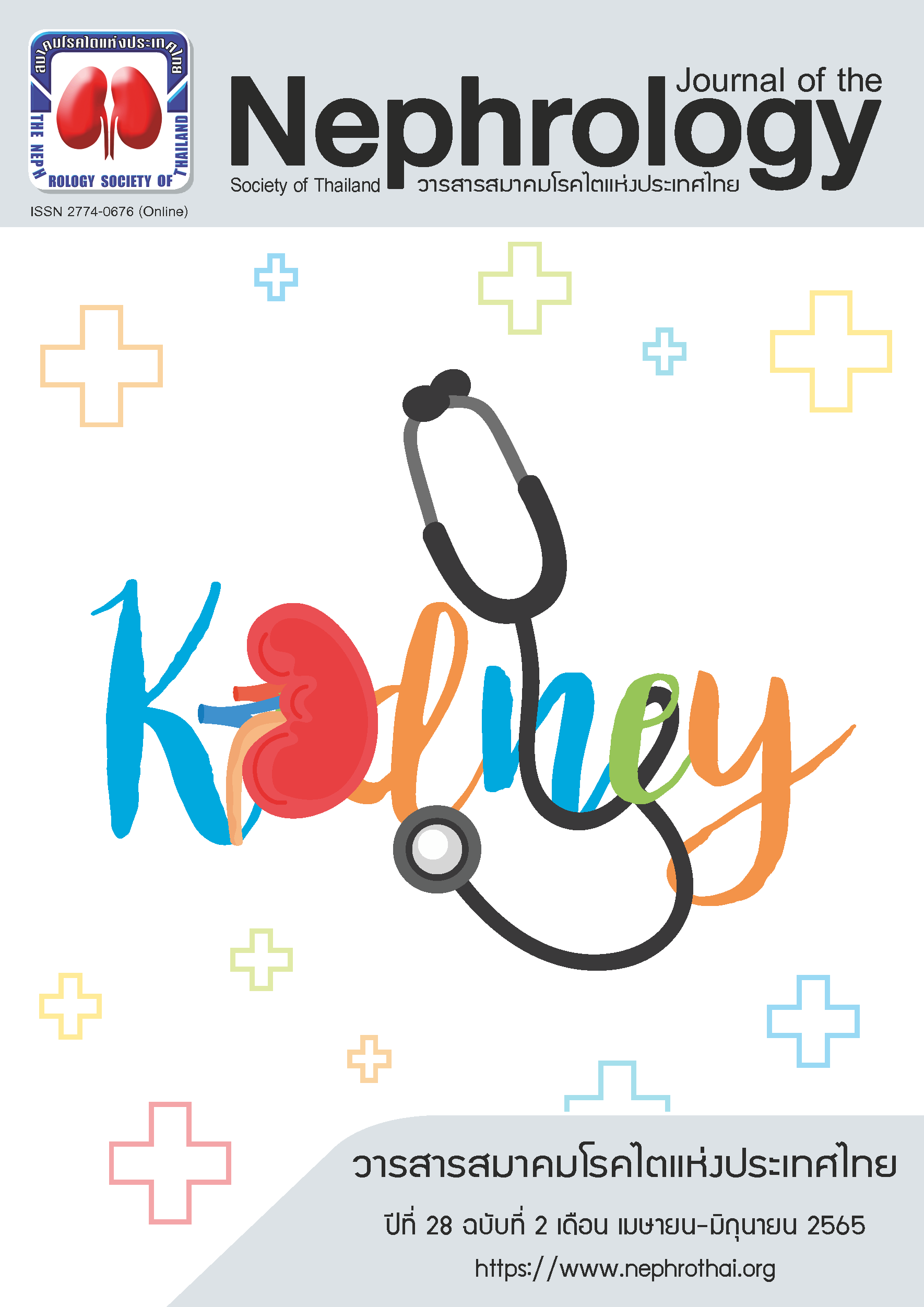ยาขับปัสสาวะ tolvaptan ในการรักษาโรคหัวใจล้มเหลวเฉียบพลัน
Main Article Content
บทคัดย่อ
ภาวะหัวใจล้มเหลวเฉียบพลันเป็นภาวะที่พบได้บ่อยในปัจจุบัน ผู้ป่วยส่วนใหญ่จะมีอาการหอบเหนื่อย ซึ่งเพิ่มอัตราการเจ็บป่วยและอัตราการเสียชีวิตจากโรคหัวใจและหลอดเลือด การรักษาหลักคือ การรักษาสาเหตุของภาวะหัวใจล้มเหลวเฉียบพลันและการใช้ยาขับปัสสาวะเพื่อขับน้ำและเกลือส่วนเกินออกจากร่างกาย ผู้ป่วยหลายรายหลังได้ยาขับปัสสาวะขนาดสูงพบว่าอาการหอบเหนื่อยไม่ดีขึ้น และเกิดผลข้างเคียงจากการใช้ยาคือ ระดับโพแทสเซียมในเลือดต่ำ ภาวะเลือดเป็นด่าง และการทำงานของไตลดลง ด้วยเหตุนี้จึงมีการคิดค้นยาตัวใหม่คือ ยาขับปัสสาวะ tolvaptan เป็นยาขับปัสสาวะชนิดรับประทานกลุ่ม vasopressin receptor antagonists (VRAs) ที่ออกฤทธิ์ต้าน V2 receptor อย่างจำเพาะเจาะจง ทำให้ aquaporin 2 channel บริเวณท่อไตส่วนปลายทำงานลดลง ส่งผลให้ลดการดูดกลับน้ำและเพิ่มการขับน้ำออกทางปัสสาวะ องค์การอาหารและยาแห่งสหรัฐอเมริกาอนุมัติให้ใช้ยา tolvaptan รักษาผู้ป่วยที่มีภาวะโซเดียมในเลือดต่ำในกลุ่มผู้ป่วยโรคหัวใจล้มเหลวเฉียบพลัน และ syndrome of inappropriate antidiuretic hormone (SIADH) นอกจากนี้จากหลายการศึกษาในปัจจุบันพบว่า ยา tolvaptan ลดอาการหอบเหนื่อย ลดน้ำหนัก เพิ่มปริมาณปัสสาวะในกลุ่มผู้ป่วยหัวใจล้มเหลวเฉียบพลัน โดยไม่มีผลต่อความผิดปกติทางเกลือแร่ และสามารถทำให้การทำงานของไตคงที่ได้
Article Details

This work is licensed under a Creative Commons Attribution-NonCommercial-NoDerivatives 4.0 International License.
บทความนี้ตีพิมพ์ภายไต้การอนุญาต CC BY-NC-ND 4.0 ซึ่งอนุญาตให้สามารถใช้บทความนี้พื่อวัตถุประสงค์ใดๆ ก็ตามที่ไม่ใช่เชิงพาณิชย์ โดยต้องมีการอ้างถึงที่มาของบทความอย่างครบถ้วน ใครก็ตามสามารถคัดลอกและแจกจ่ายทุกส่วนของบทความนี้โดยไม่ต้องขออนุญาตจากผู้ประพันธ์หรือสมาคมโรคไตแห่งประเทศไทย
References
Ariyachaipanich A, Krittayaphong R, Kunjara Na Ayudhya R, Yingchoncharoen T, Buakhamsri A, Suvachittanont N. Heart Failure Council of Thailand (HFCT) 2019 Heart Failure Guideline: Introduction and Diagnosis. J Med Assoc Thai 2019;102:231-9.
Cadnapaphornchai MA, Gurevich AK, Weinberger HD, Schrier RW. Pathophysiology of sodium and water retention in heart failure. Cardiology, 2001. 96(3-4): 122-31.
Schrier RW, Abraham WT. Hormones and hemodynamics in heart failure. N Engl J Med, 1999. 341(8): 577-85.
Weber KT. Aldosterone in congestive heart failure. N Engl J Med. 2001; 345(23):1689-97.
Vinod P, Krishnappa V, Chauvin AM, Khare A, Raina R. Cardiorenal Syndrome: Role of Arginine Vasopressin and Vaptans in Heart Failure. Cardiol Res. 2017; 8(3):87-95.
ter Maaten JM, Valente MA, Damman K, Hillege HL, Navis G, Voors AA. Diuretic response in acute heart failure-pathophysiology, evaluation, and therapy. Nat Rev Cardiol. 2015; 12(3):184-92.
Ellison DH. Diuretic therapy and resistance in congestive heart failure. Cardiology. 2001;96(3-4):132-43.
Testani JM, Brisco MA, Kociol RD, Jacoby D, Bellumkonda L, Parikh CR, et al. Substantial Discrepancy Between Fluid and Weight Loss During Acute Decompensated Heart Failure Treatment. Am J Med. 2015; 128(7): 776-83.e4.
Testani JM, Hanberg JS, Cheng S, Rao V, Onyebeke C, Laur O, et al. Rapid and Highly Accurate Prediction of Poor Loop Diuretic Natriuretic Response in Patients With Heart Failure. Circ Heart Fail. 2016; 9(1): e002370.
Damman K, Testani JM. The kidney in heart failure: an update. Eur Heart J. 2015; 36(23):1437-44.
Phakdeekitcharoen B, Boonyawat K. The added-up albumin enhances the diuretic effect of furosemide in patients with hypoalbuminemic chronic kidney disease: a randomized controlled study. BMC Nephrol. 2012; 13:92.
Sweet DH, Bush KT, Nigam SK. The organic anion transporter family: from physiology to ontogeny and the clinic. Am J Physiol Renal Physiol. 2001; 281(2):F197-205.
Wilcox CS, Mitch WE, Kelly RA, Skorecki K, Meyer TW, Friedman PA, et al. Response of the kidney to furosemide. I. Effects of salt intake and renal compensation. J Lab Clin Med. 1983; 102(3):450-8.
Brater DC. Diuretic therapy. N Engl J Med. 1998; 339(6):387-95.
Grodin JL, Stevens SR, de Las Fuentes L, Kiernan M, Birati EY, Gupta D, et al. Intensification of Medication Therapy for Cardiorenal Syndrome in Acute Decompensated Heart Failure. J Card Fail. 2016; 22(1):26-32.
Schrier RW, Fassett RG, Ohara M, Martin PY. Vasopressin release, water channels, and vasopressin antagonism in cardiac failure, cirrhosis, and pregnancy. Proc Assoc Am Physicians. 1998; 110(5):407-11.
Aditya S, Rattan A. Vaptans: A new option in the management of hyponatremia. Int J Appl Basic Med Res. 2012; 2(2):77-83.
Mayinger B, Hensen J. Nonpeptide vasopressin antagonists: a new group of hormone blockers entering the scene. Exp Clin Endocrinol Diabetes. 1999;107(3):157-65.
Yamamura Y, Ogawa H, Yamashita H, Chihara T, Miyamoto H, Nakamura S, et al. Characterization of a novel aquaretic agent, OPC-31260, as an orally effective, nonpeptide vasopressin V2 receptor antagonist. Br J Pharmacol. 1992; 105(4):787-91.
Ali F, Guglin M, Vaitkevicius P, Ghali JK. Therapeutic potential of vasopressin receptor antagonists. Drugs. 2007;67(6):847-58
Decaux G, Soupart A, Vassart G. Non-peptide arginine-vasopressin antagonists: the vaptans. Lancet. 2008; 371(9624):1624-32.
Farmakis D, Filippatos G, Kremastinos DT, Gheorghiade M. Vasopressin and vasopressin antagonists in heart failure and hyponatremia. Curr Heart Fail Rep. 2008; 5(2):91-6.

